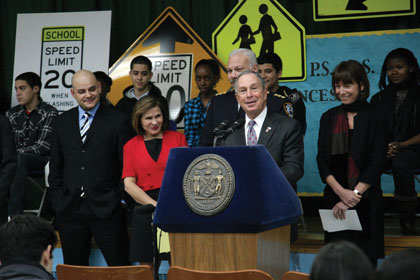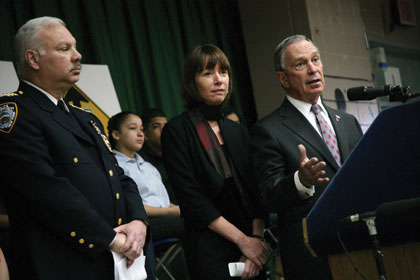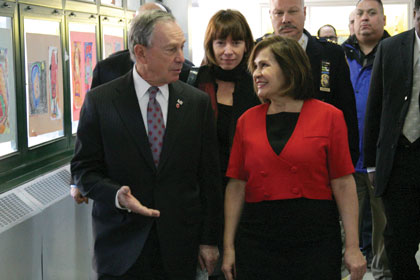MAYOR BLOOMBERG, TRANSPORTATION COMMISSIONER SADIK-KHAN ANNOUNCE ALL TIME RECORD YEAR FOR TRAFFIC SAFETY
256 Traffic Fatalities in 2009, the Lowest Level in Recorded City History
Traffic Fatalities Down 35 Percent Compared to 2001 Levels

Mayor Bloomberg and Department of Transportation Commissioner Sadik-Khan announced that New York City traffic fatalities fell to an all-time record low in 2009.
Photos: Edward Reed
On January 27th 2009, Mayor Michael R. Bloomberg and Department of Transportation Commissioner Janette Sadik-Khan announced that New York City traffic fatalities fell to an all time record low in 2009. Last year there were 256 traffic fatalities in New York City representing 12 percent fewer than in 2008, and a 35 percent reduction compared to 2001. The previous record low was established in 2007 with 274 fatalities.
Traffic safety records have been kept in New York City since 1910. Since 2001, safety gains have been made across all categories:
- vehicle drivers and passengers,
- pedestrians,
- bicyclists and seniors, the population most vulnerable to traffic fatalities.
The reductions in fatalities come as the City has instituted unprecedented safety improvements in street engineering and expanded NYPD enforcement of traffic laws across the five boroughs. The Mayor announced the record safety statistics at P.S. 384, the Frances E. Carter School, where the Safe Routes to Schools program and a 20 m.p.h speed zone have been installed. The Mayor was joined by NYPD Chief of Transportation James Tuller, City Council Member Erik Martin Dilan, P.S. 384 Principal Brunhilda Perez and P.S. 53 Principal Luis Quintana.
"Even one traffic fatality is one too many, but our aggressive efforts to improve traffic safety have produced life savings results - an all-time record low for fatalities in 2009," said Mayor Bloomberg. "While traffic deaths are down 35 percent from 2001 levels we have more work do to, and we will continue pressing forward with better traffic engineering, stricter traffic enforcement and greater public awareness about traffic safety. Our goal is very simple: continue making our streets safer for everyone."
"While these numbers are at historic lows, we are committed to do even more to drive them down further," said Commissioner Sadik-Khan. "We will continue to engineer safer streets, but the fact is that too many accidents are preventable involving inattention, speeding, drunk driving and motorists who simply fail to yield to pedestrians in crosswalks. Working with NYPD we will work to keep New Yorkers safe from reckless motorists who put everyone on the road in jeopardy."
"NYPD enforcement is aimed at saving lives," said Chief James Tuller, NYPD Chief of Transportation. "That's why we focus, with positive results, on known killers including DWI, driving while phoning and texting, and speeding."
- Fatalities for vehicle drivers and vehicle passengers are down 63 percent compared to 2001, down from 163 in 2001 to 61 in 2009.
- Fatalities for vehicle drivers and vehicle passengers and have dropped 20 percent since 2008.
- Pedestrian fatalities are down by 19 percent compared to 2001, down from 191 in 2001 to 155 in 2009.
- Pedestrian fatalities increased slightly compared to 2008 levels when 151 occurred.
- Fatalities for cyclists have been reduced by 54 percent compared to 2008, from 26 to 12. In 2001, there were 13 fatal accidents involving cyclists, but since that time the estimated number of people cycling the city has more than tripled with commuter cycling growing by 26 percent in the last year alone. The City bike lane network has more than doubled since 2006 growing by more than 225 miles.
- Senior citizen traffic deaths have been reduced by 41 percent compared to 2001, down from 91 to 54 in 2009.
- Senior citizens traffic fatalities have dropped 24 percent since 2008.

The Department of Transportation's strategic plan set a goal to cut all traffic fatalities 50 percent by 2030 compared to 2007 figures. This year the department will launch and expand more aggressive safety initiatives tripling the number of reduced speed zones around schools, launching new anti-drunk driving and anti-speeding advertising campaigns and will continue to work to engineer safer streets for children, seniors and everyone who uses the City's streets.
The Department of Transportation has taken unprecedented steps to expand street safety engineering in all five boroughs. The agency has greatly expanded traffic calming measures through its Safe Streets for Seniors and Safe Routes to Schools program bringing shorter pedestrian crossings, expanded traffic islands and improved street design, wider sidewalks and more traffic calming measures to thousands of locations across the city.
In addition, the agency has:
- installed signals that give pedestrians a head start at crosswalks before cars moving in the same direction get a green light,
- introduced the nation's first protected bicycle paths, and
- launched systematic intersection improvements at key locations such as 1st Avenue and 57th Street in Manhattan,
- pedestrian safety improvements at The Hub in The Bronx and at Tillary and Adams Streets at the foot of the Brooklyn Bridge,
- a one way conversion on a portion of Barnett Avenue in Sunnyside, Queens, and
- new pedestrian improvements along Hylan Boulevard near New Dorp Lane in Staten Island, as well as
- targeting other high accident locations citywide,
- the department also launched public awareness campaigns such as the LOOK campaign which encourage drivers and cyclists to be aware of each other, and
- an upcoming Stop DWI marketing campaign and other outreach efforts to encourage safe practices.
P.S. 384 became a Safe Routes to Schools location in 2008 and, in addition, became a 20 m.p.h speed zone in 2008. The Department of Transportation has completed operational improvements at 135 Safe Routes to Schools locations and the agency is currently studying a second round of 135 elementary and middle schools as part of the program. The agency recently announced that this year it will triple the number of 20 m.p.h. speed zones around schools from 25 to 75.
The City has an aggressive traffic safety agenda in Albany seeking legislation to:
- install speed cameras at locations throughout the city,
- mandate improved truck safety mirrors,
- strengthen work zone safety regulations, and
- increase penalties for hit and run motorists.
In addition to engineering and education, increased safety also requires strong enforcement of traffic laws to focus on drunken driving, speeding and seatbelt use. An upcoming pedestrian injury report will show that that many accidents are caused by vehicular speeding or failure to yield to pedestrians. Moving forward, the Department of Transportation will collaborate with NYPD to focus enforcement against these causes. Reductions in traffic fatalities are also helped by advances in vehicle safety design such as air bags and improved brakes and collision avoidance systems, and improved medical trauma services.

© 2014 TLC Magazine Online, Inc. |


